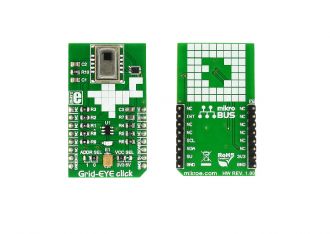
We strongly encourage users to use Package manager for sharing their code on Libstock website, because it boosts your efficiency and leaves the end user with no room for error. [more info]

Rating:
Author: MIKROE
Last Updated: 2019-07-30
Package Version: 1.0.0.1
mikroSDK Library: 1.0.0.0
Category: Temperature & humidity
Downloaded: 6372 times
Not followed.
License: MIT license
Grid-EYE click is a 8x8 thermal array sensor-detector, that carries the AMG8853 infrared array sensor from Panasonic. The click is designed to run on either 3.3V or 5V power supply. It communicates with the target MCU over I2C interface.
Do you want to subscribe in order to receive notifications regarding "Grid-EYE click" changes.
Do you want to unsubscribe in order to stop receiving notifications regarding "Grid-EYE click" changes.
Do you want to report abuse regarding "Grid-EYE click".

Library Description
The library covers all the necessary functions that enables the usage of the Grid-EYE Click board. It initializes and defines the I2C bus driver and drivers that offer a choice for writing and reading one byte or two bytes of data in and from registers. User can also read the whole grid that represents values of each of 64 sensors. Also, the user has different settings at his disposal.
Key functions:
void grideye_readGrid( uint8_t *buffer ) - Function is used to read the data from the whole sensor grid.void grideye_defSettings() - Function is used to apply default settings.void grideye_initialReset() - Function is used to perform initial reset.Examples description
The application is composed of three sections :
void applicationTask()
{
grideye_readGrid( &gridArray );
for( i = 1; i < 9; i++ )
{
for( j = 1; j < 9; j++ )
{
mikrobus_logWrite( "| ", _LOG_TEXT );
gridArrayTmp = gridArray[ i * j ];
WordToStr( gridArrayTmp, logTxt );
mikrobus_logWrite( logTxt, _LOG_TEXT );
mikrobus_logWrite( " ", _LOG_TEXT );
}
mikrobus_logWrite( " ", _LOG_LINE );
mikrobus_logWrite( "----------------------------------------------------------------", _LOG_LINE );
}
mikrobus_logWrite( " ", _LOG_LINE );
mikrobus_logWrite( " ", _LOG_LINE );
Delay_ms( 1000 );
}
Other mikroE Libraries used in the example:
Additional notes and informations
Depending on the development board you are using, you may need USB UART click, USB UART 2 click or RS232 click to connect to your PC, for development systems with no UART to USB interface available on the board. The terminal available in all MikroElektronika compilers, or any other terminal application of your choice, can be used to read the message.